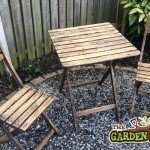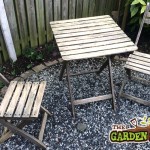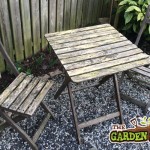After months of freezing conditions, wind, rain, sleet and snow our garden furniture can look the worst for wear come early spring. So, one of the first tasks on my list this year was to rejuvenate my garden furniture. For this you would need a few basic tools including sand paper, a paint brush and some wood stain or oil
I started by sanding down the table and chairs using a rough or coarse sand paper. When doing this it is important to sand the furniture down to the original wood colour. This will ensure an even appearance of the furniture once the stain has been applied
- Garden Furniture
- Sanded Furniture
- Worn Furniture
I found that by sanding, I was able to remove all green mould that hard started to set in on the furniture. I also found that the legs of the table and chairs were in bad need of a good sanding as they were the most weathered part of the garden furniture
The coarser the sand paper the quicker the job and the more time you can devot to the hard to reach parts such as in between the timber lathes on the table & chairs
Once all the furniture has been sanding down to the original surface you can begin to apply the oil, stain or preservative. This is crucial to provide a protective outer coat over the entire surface of the garden furniture, protecting it from summer sun and winter conditions
The stain will also soak into the wood and prevent the wood from drying out and cracking, which is the most common form of wear and tear that your garden furniture will experience. The stain should be applied evenly over the surface and can be rubbed in in a circular motion
You don’t need a paint brush when using a wood oil all you need is an old, clean rag. Simply pour a small amount of oil onto the rag and rub it into the timber until you have achieved an even application and there is no oil collecting on the furniture surface
Allow 6 hours for the stain to dry in. you can give the furniture a second application if you are not satisfied with the level of the stain


